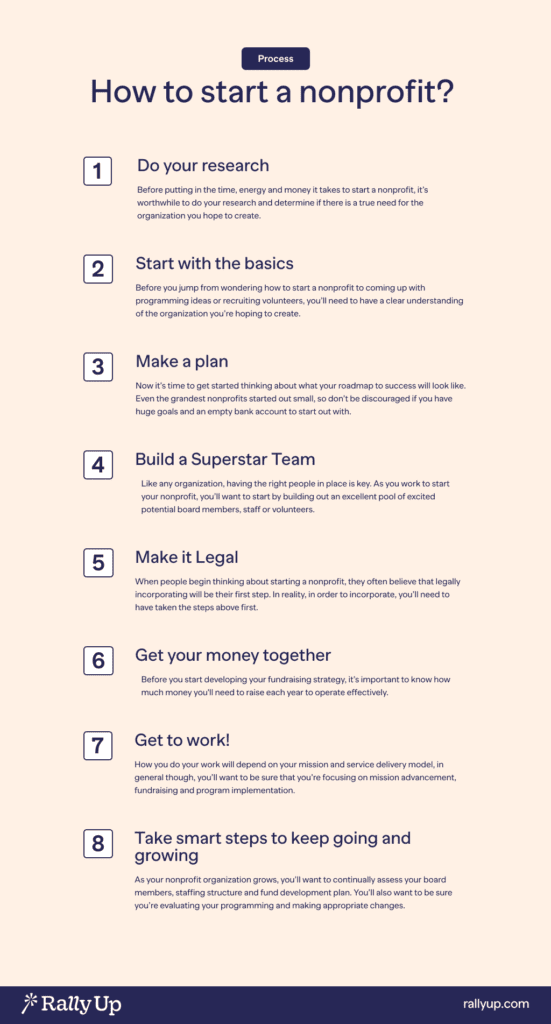Most people who aim to start a nonprofit organization spend a long time thinking about the difference they hope to make in the world. Some people feel inspired after struggling or seeing a loved one struggle without support. Others see a community need and no one filling it. Still, others have ideas that create innovative solutions to problems that seem unsolvable.
No matter what got you thinking about starting a nonprofit, it’s important to have a clear understanding of the process if you want to be successful. This article will explore the steps you need to take to turn your idea into a reality as you start your very own nonprofit organization!

What is a nonprofit?
Before you begin thinking about how to start a nonprofit, it’s important to understand what a nonprofit is and whether your idea fits within those parameters. Many for-profit organizations do good in the world or raise money for charitable causes, but this does not make them a nonprofit. The most basic definition of a nonprofit organization is that it must operate and provide services without the primary goal of making a profit. That doesn’t mean that it can’t sell goods or charge for services, just that any money made is invested back into the mission and does not go anywhere else. Nonprofits must also serve the public interest (so basically, do something good) and are tax-exempt by the IRS. Organizations can apply for 501(c)3 status if their focus is:
- Charitable
- Educational
- Literacy related
- Religious
- Scientific
- Public safety
- The promotion of armature sports
- The prevention of cruelty towards children or animals
What are the benefits of being a nonprofit?
An organization does not necessarily have to be a nonprofit to do good in the world. People can collectively raise money for mutual aid, volunteer in their community, or work to make positive changes in the world without starting a nonprofit. However, there are several significant benefits to starting a nonprofit.
One of the primary benefits of becoming a nonprofit organization is receiving tax-exempt status from the IRS. As a tax-exempt organization, a nonprofit is not required to pay state or federal income tax. They’re also able to accept contributions and donations that are then tax-exempt for the donor. Nonprofits are also (depending on the state) often exempt from paying property taxes.
In addition to tax-related benefits, becoming a legitimate nonprofit opens the door to additional funding opportunities, as many grants and other private or public allocations are only available to nonprofits. Nonprofits also receive discounts on bulk-mail rates and (often) other professional services. Perhaps most importantly, they gain the legitimacy of official nonprofit status, making it far easier to raise funds and be taken seriously in the greater community.
How do I start a nonprofit?
Starting a nonprofit organization often takes a great deal of time and energy. Staying organized and following the steps below will help ensure that you’re on the right track every step of the way! And remember, no one is born knowing how to start a nonprofit. At the beginning of every great nonprofit journey, someone wondered how to start a nonprofit!

Step 1: Do your research
Before putting in the time, energy, and money it takes to start a nonprofit, it’s worthwhile to do your research and determine if there is a true need for the organization you hope to create. If you’re passionate about making sure that elder foster dogs have a comfortable place to spend their last years, but there are already several organizations successfully making this happen in your area, you may want to consider whether your time is best spent starting a whole new organization or volunteering and supporting one that already exists.
Likewise, it’s important to determine if you are the best person to spearhead an initiative. Sometimes well-meaning individuals see a problem and want to solve it but, because they don’t belong to the community they’re trying to help, they don’t have a true understanding of the challenges or solutions that might be effective.
If you’ve determined that there is a need for your organization and that you’re the best person to help fill this need, then it’s time to start planning for success.
Step 2: Start with the basics
Before you jump from wondering how to start a nonprofit to coming up with programming ideas or recruiting volunteers, you’ll need to have a clear understanding of the organization you’re hoping to create. Start by brainstorming with any partners or primary supporters you have. Talk through your long-term goals and come up with a mission and vision statement.
A mission statement is the foundation of your work. It will describe what you do and will provide guidance as you make day-to-day decisions. It can be helpful to look at other organizations’ mission statements to get a feel for how you want yours to look and what you want it to convey.
A vision statement shares what you hope to see if your nonprofit reaches all its goals. It is aspirational and concise and should make all your stakeholders smile. Again, peeking at the vision statements of other nonprofit organizations you admire can help guide you as you create your own.
You’ll also need to come up with a name. The best nonprofits have clear, concise names that quickly convey what they do.
Step 3: Make a plan
Now that you have a name, a mission statement, and a vision statement, it’s time to get started thinking about what your roadmap to success will look like. Even the grandest nonprofits started out small, so don’t be discouraged if you have huge goals and an empty bank account to start out with.
To begin planning, you’ll need to do some research, and not just on how to start a nonprofit organization. If your nonprofit will focus on improving dropout rates in your district, you’ll want to know things like what the rates have been historically, how the rates look different at different schools within the district, what has worked to boost rates in similar areas, and what schools and other organizations in your area are already doing.
Doing good research can help you make a solid roadmap. As you start to make your roadmap, it can be helpful to consider where you want to be in five years. Think about what you want to have accomplished, how you want to be staffed, and what you want to be working towards.
Now, work backwards. Think about everything that will need to happen before you reach that five-year mark to make sure you end up where you want to be. For example, if you want to lower the dropout rate from 20% to 15% within five years and you’ve identified that mentoring support is a key factor in a student’s decision to stay enrolled in school, you might set the goal to be mentoring at least 300 students across at least 5 schools at the five-year mark. You can then think about where you want to be and set goals for year 4, year 3, year 2, and (most actionably) year 1. Appropriate goals for the end of year 1 might look like having built relationships with the administration at 1 school, recruited 25 volunteers to serve as mentors, and hired one social worker to oversee the program.
Step 4: Build a Superstar Team
Like any organization, having the right people in place is key. As you work to start your nonprofit, you’ll want to start by building out an excellent pool of excited potential board members, staff, or volunteers.
Board members play an integral role in shaping a nonprofit and setting it up for success. They will be responsible for guiding strategy, supporting operations, hiring leadership, and a range of other roles. In the early days of a nonprofit, before they are resourced enough for paid staff positions, many organizations utilize a ‘working board.’ A working board takes on roles voluntarily that are traditionally paid, such as marketing, programming, and fundraising.
Identifying board members can be exciting but it’s important that you also be highly selective. Not everyone who raises their hand should necessarily get a spot on the board. You need individuals who are committed to action, who understand how to start a nonprofit organization and who truly believe in your mission.
In the early days of most nonprofits, when resources are scarce, volunteers and board members run the show. Paid staff often only come along when the organization can raise enough money to pay them. If you can hire staff due to a startup grant or donation, you’ll want to follow the same rigorous hiring protocol you would in any other industry.
Step 5: Make it Legal
When people begin thinking about starting a nonprofit, they often believe that legally incorporating will be their first step. In reality, in order to incorporate, you’ll need to have taken the steps above first. To incorporate your nonprofit organization, you must have:
- Named for your organization.
- Appointed your board.
- Determined your legal structure.
- Filed incorporation paperwork
- Applied for tax exemption
- Obtained the required licenses
The process for filing incorporation paperwork, applying for tax exemption, and obtaining required licenses varies from state to state but, in general, you can find the information you need by looking at your state’s government page. There is typically a small fee involved with filing all the necessary paperwork, although board members or early donors often cover these fees.
Step 6: Get your money together
One of the toughest parts of starting a nonprofit is figuring out how you’re going to fundraise. Before you start developing your fundraising strategy, it’s important to know how much money you’ll need to raise each year to operate effectively. Working with your board, go back to your roadmap and work to identify any costs associated with the milestones you’ve marked for each year. After developing an understanding of how much money you’ll need to raise, it’s time to get to work!
There are several ways nonprofits typically obtain the money they need to operate effectively. These include:
- Grants
Depending on what your nonprofit does, you’ll likely be able to apply for a range of federal, state, or local grants. Grant writing is a skill and, if you don’t have a grant writer on your board, you’ll likely need to hire or contract someone to write your grant proposals. Grants can be difficult to get in the early years of a nonprofit, as you typically must have some evidence of effectiveness before your proposals are accepted, but there are some grants that are designed specifically to help new nonprofits get off the ground.
- Private donors
Private donors are important in the early years of a nonprofit when they have yet to demonstrate their impact on the community. Some nonprofits have giving requirements for board members while others require board members to raise a certain amount of money from their own social circles each year.
- Corporate donors
Corporations or local businesses are often willing to offer in-kind donations to nonprofits in their community. While you might be able to convince some business leaders to give money, you will probably have a better chance of asking for donations in the form of free professional services, gift cards, or products. Most big box stores have individual store budgets for local giving. Find out what their giving calendar is (many allocate a certain amount each month) and be sure to ask when you know they have something to give.
- Fundraising events
Fundraising events are a great way to engage existing donors as well as raise community awareness and excite potential donors. While fundraising events used to come with a lot of costs and overhead, many organizations are able to utilize online fundraising platforms to host fundraising events without having to spend any money at all.
No matter how you fundraise, it’s important to have a solid plan for how you’ll raise money in the early years and as you grow.
Step 7: Get to work!
Once you’ve done the work to set your organization up for success, it’s time to get to work! How you do your work will depend on your mission and service delivery model, in general though, you’ll want to be sure that you’re focusing on mission advancement, fundraising, and program implementation.
Mission advancement, or getting your name out there, is important because you’ll want to be known as the ‘go-to’ organization whenever anyone thinks about the issue you address. One way you can work to advance your mission by getting to know (and offering to partner) with organizations doing similar work to you or those who are working with the population you want to serve. You might also work with local journalists or storytellers to share what you’re doing and how the community can help or getting to know local government officials.
Fundraising will need to be an ongoing part of your work. As you fundraise, be sure to work towards developing a healthy mix of grants, donations, and other streams of income. Some organizations operate on a fee-for-service model while others choose to offer all their services free of charge. Whatever you decide, you’ll need to constantly be thinking months and, sometimes, even years ahead as you continue to scale up your fundraising to meet your growing needs.
Program implementation is probably what you’ve been looking forward to since you started daydreaming about your nonprofit. Before you start offering services, you’ll have to work hard to develop your service delivery model. Think through who you want to serve, how you want to serve them, and what you’ll do to ensure that there are no barriers to them receiving your services. As you develop your model, you can ensure that it is relevant to the population you’re working to serve by including a wide range of voices in your process. It’s also important to be open to evaluating as you go and making the necessary changes.
Step 8: Take smart steps to keep going and growing
It can feel both daunting and exciting when you go from “how do I start a nonprofit?” to “how do I run a nonprofit?” Successful nonprofit leaders are typically skilled at thinking in the short, medium and long term to ensure that they’re not either so caught up in the day-to-day that they forget to plan for five years from now, or, that they’re so caught up thinking of the long-term vision that they let their day-to-day responsivities slide.
As your nonprofit organization grows, you’ll want to continually assess your board members, staffing structure, and fund development plan. You’ll also want to be sure you’re evaluating your programming and making appropriate changes. You might find that you need more or more diverse board members, that your staff roles need to shift, or that your program model needs some adjustment. Strategic retreats, or times when you and your key stakeholders step away from day-to-day responsibilities to think deeply about what’s working, what’s not working, and what you want to do going forward, can be helpful.
You’ll also want to make sure that your community stays involved and remains excited about your mission as you grow. You may find that you need to visit and revisit your purpose, philosophy, and way of doing things over time. That is a good thing! If you’re not honoring the voices of the people you aim to serve, it’s very unlikely that you’ll be able to fulfill your mission.
If you’ve made it this far, you’re probably ready to get started! Taking the first step can feel like a huge leap but all great things started small. Building a successful nonprofit organization from the ground up is a huge undertaking but if you have the passion, the drive, and the help and support of the right people, you’re sure to do great things.
